Synthesis, Spectroscopic, and Theoretical Study of Copper and Cobalt Complexes with Dacarbazine
Abstract
1. Introduction
2. Materials and Methods
2.1. Synthesis
2.2. Methods
3. Results and Discussion
3.1. IR and Raman Spectra
3.2. NMR Spectra
3.3. Structure, Aromaticity, and NBO Analysis of Dacarbazine and Copper and Cobalt Complexes
3.4. HOMO and LUMO Orbitals
3.5. Docking Studies
3.6. Thermogravimetric Study
4. Conclusions
Supplementary Materials
Author Contributions
Funding
Institutional Review Board Statement
Informed Consent Statement
Data Availability Statement
Conflicts of Interest
References
- Serrone, L.; Zeuli, M.; Sega, F.M.; Cognetti, F. Dacarbazine-based chemotherapy for metastatic melanoma: Thirty-year experience overview. J. Exp. Clin. Cancer Res. 2000, 19, 21–34. [Google Scholar]
- Reid, J.M.; Kuffel, M.J.; Miller, J.K.; Rios, R.; Ammes, M.M. Metabolic activation of dacarbazine by human cytochromes p450: The role of CYP1A1, CYP1A2e CYP2E1. Clin. Cancer Res. 1999, 5, 2192–2197. [Google Scholar]
- Nussbaumera, S.; Bonnabry, P.; Veuthey, J.L.; Fleury-Souverain, S. Analysis of anticancer drugs: A review. Talanta 2011, 85, 2265–2289. [Google Scholar] [CrossRef] [PubMed]
- Moody, C.L.; Wheelhouse, R.T. The Medicinal Chemistry of Imidazotetrazine Prodrugs. Pharmaceuticals 2014, 7, 797–838. [Google Scholar] [CrossRef] [PubMed]
- Bonmassar, L.; Marchesi, F.; Pascale, E.; Franzese, O.; Margison, G.P.; Bianchi, A.; D’Atri, S.; Bernardini, S.; Lattuada, D.; Bonmassar, E.; et al. Triazene compounds in the treatment of acute myeloid leukemia: A short review and a case report. Curr. Med. Chem. 2013, 20, 2389–2401. [Google Scholar] [CrossRef] [PubMed]
- Marchesi, F.; Turriziani, M.; Tortorelli, G.; Avvisati, G.; Torino, F.; Vecchis, L.D. Triazene compounds: Mechanism of action and related DNA repair systems. Pharmacol. Res. 2007, 56, 275–287. [Google Scholar] [CrossRef]
- Pourahmad, J.; Amirmostofian, M.; Kobarfard, F.; Shahraki, J. Biological reactive intermediates that mediate dacarbazine cytotoxicity. Cancer Chemother. Pharmacol. 2009, 65, 89–96. [Google Scholar] [CrossRef]
- Hayward, I.P.; Parson, P.G. Epigenetic effects of the methylating agent 5-(3-dimethyl-1-triazeno)-imidazole-4-carboxamide in human melanoma cells. Aust. J. Exp. Biol. Med. Sci. 1984, 62, 597–606. [Google Scholar] [CrossRef]
- Al-Qatati, A.; Aliwaini, S. Combined pitavastatin and dacarbazine treatment activates apoptosis and autophagy resulting in synergistic cytotoxicity in melanoma cells. Oncol. Lett. 2017, 14, 7993–7999. [Google Scholar] [CrossRef]
- Naserian, M.; Ramazani, E.; Iranshahi, M.; Tayarani-Najaran, Z. The Role of SAPK/JNK pathway in the synergistic effects of metformin and dacarbazine on apoptosis in Raji and Ramos lymphoma cells. Curr. Mol. Pharmacol. 2018, 11, 336–342. [Google Scholar] [CrossRef]
- Finotello, R.; Stefanello, D.; Zini, E.; Marconato, L. Comparison of doxorubicin–cyclophosphamide with doxorubicin–dacarbazine for the adjuvant treatment of canine hemangiosarcoma. Vet. Comp. Oncol. 2015, 15, 25–35. [Google Scholar] [CrossRef]
- Song, M.; Zhang, R.; Wang, X. Nano-titanium dioxide enhanced biosensing of the interaction of dacarbazine with DNA and DNA bases. Mater. Lett. 2006, 60, 2143–2147. [Google Scholar] [CrossRef]
- Shen, Q.; Wang, X.; Fu, D. The amplification effect of functionalized gold nanopar-ticles on the binding of anticancer drug dacarbazine to DNA and DNA bases. Appl. Surf. Sci. 2008, 255, 577–580. [Google Scholar] [CrossRef]
- Matejczyk, M.; Świsłocka, R.; Golonko, A.; Lewandowski, W.; Hawrylik, E. Cytotoxic, genotoxic and antimicrobial activity of caffeic and rosmarinic acids and their lithium, sodium and potassium salts as potential anticancer compounds. Adv. Med. Sci. 2008, 63, 14–21. [Google Scholar] [CrossRef]
- Jabłońska-Trypuć, A.; Świderski, G.; Krętowski, R.; Lewandowski, W. Newly synthesized doxorubicin complexes with selected metals—Synthesis, structure and anti-breast cancer activity. Molecules 2017, 22, 1106. [Google Scholar] [CrossRef]
- Trynda-Lemiesz, L.; Śliwińska-Hill, U. Kompleksy metali w terapii nowotworowej. Teraźniejszość i przyszłość. J. Oncol. 2011, 61, 465–474. [Google Scholar]
- Kumari, T.; Shukla, J.; Joshin, S. Study on the complex formation and anticancer effect of complex, zinc(II)-dacarbazine. Int. J. Chem. Sci. 2011, 9, 1751–1762. [Google Scholar]
- Shukla, J.; Pitre, K.S. Role of bio-metal Fe(III) in anticancer effect of dacarbazine. Indian J. Physiol. Pharmacol. 1998, 42, 223–230. [Google Scholar]
- Temerk, Y.; Ibrahim, H.I. Binding mode and thermodynamic studies on the interaction of the anticancer drug dacarbazine and dacarbazine–Cu(II) complex with single and double stranded DNA. J. Pharm. Biomed. Anal. 2014, 95, 26–33. [Google Scholar] [CrossRef]
- Lewandowski, W.; Kalinowska, M.; Lewandowska, H. The influence of metals on the electronic system of biologically important ligands, Spectroscopic study of benzoates, salicylates, nicotinates and isoorates. Review. J. Inorg. Biochem. 2005, 99, 1407–1423. [Google Scholar] [CrossRef]
- Koczoń, P.; Hrynaszkiewicz, T.; Świsłocka, R.; Samsonowicz, M.; Lewandowski, W. Spectroscopic (Raman, FT-IR and NMR) study of alkaline metal nicotinates and isonicotinates. Vib. Spectrosc. 2003, 33, 215–222. [Google Scholar] [CrossRef]
- Lewandowska, M.; Janowski, A.; Lewandowski, W. Spectroscopic Investigations on Lanthanide Complexes with Salicylic Acid. Can. J. Spectr. 1984, 29, 87–92. [Google Scholar]
- Lewandowski, W.; Kalinowska, M.; Lewandowska, H. The influence of halogens on the electronic system of biologically important ligands. Spectroscopic study of halogenobenzoic acids, halogenobenzoates and 5-halogenouracils. Review. Inorg. Chim. Acta 2005, 358, 2155–2166. [Google Scholar] [CrossRef]
- Koczoń, P.; Piekut, J.; Borawska, M.; Lewandowski, W. Vibrational structure and antimicrobial activity of selected isonicotinates, potassium picolinate and nicotinate. J. Mol. Struct. 2003, 651–653, 651–656. [Google Scholar] [CrossRef]
- Kalinowska, M.; Borawska, M.; Świsłocka, R.; Piekut, J.; Lewandowski, W. Spectroscopic (IR, Raman, UV, 1H and 13C NMR) and microbiological studies of Fe(III), Ni(II), Cu(II), Zn(II) and Ag(I) picolinates. J. Mol. Struct. 2007, 834–836, 419–425. [Google Scholar] [CrossRef]
- Świderski, G.; Świsłocka, R.; Łyszczek, R.; Wojtulewski, S.; Samsonowicz, M.; Lewandowski, W. Thermal, spectroscopic, X-ray and theoretical studies of metal complexes (sodium, manganese, copper, nickel, cobalt and zinc) with pyrimidine-5-carboxylic and pyrimidine-2-carboxylic acids. J. Therm. Anal. Calorim. 2019, 138, 2813–2837. [Google Scholar] [CrossRef]
- Świderski, G.; Wojtulewski, S.; Kalinowska, M.; Świsłocka, R.; Wilczewska, A.Z.; Pietryczuk, A.; Cudowski, A.; Lewandowski, W. The influence of selected transition metal ions on the structure, thermal and microbiological properties of pyrazine-2-carboxylic acid. Polyhedron 2020, 175, 114173. [Google Scholar] [CrossRef]
- Świderski, G.; Łyszczek, R.; Wojtulewski, S.; Kalinowska, M.; Świsłocka, R.; Lewandowski, W. Comparison of structural, spectroscopic, theoretical and thermal properties of metal complexes (Zn, Mn (II), Cu (II), Ni (II) and Co (II)) of pyridazine-3-carboxylic acid and pyridazine-4-carboxylic acids. Inorg. Chim. Acta 2020, 512, 119865. [Google Scholar] [CrossRef]
- Świderski, G.; Kalinowska, M.; Wilczewska, A.Z.; Malejko, J.; Lewandowski, W. Lanthanide complexes withpyridinecarboxylic acids–Spectroscopic and thermal studies. Polyhedron 2018, 150, 97–109. [Google Scholar] [CrossRef]
- Świderski, G.; Kalinowska, M.; Rusinek, I.; Samsonowicz, M.; Rzączyńska, Z.; Lewandowski, W. Spectroscopic (IR, Raman) and thermogravimetric studies of 3d-metal cinchomeronates and dinicotinates. J. Therm. Anal. Calorim. 2016, 126, 1521–1532. [Google Scholar] [CrossRef][Green Version]
- Świderski, G.; Lewandowska, H.; Świsłocka, R.; Wojtulewski, S.; Siergiejczyk, L.; Wilczewska, A.Z.; Misztalewska, I. Spectroscopic (IR, Raman, NMR), thermal and theoretical (DFT) study of alkali metal dipicolinates (2,6) and quinolinates (2,3). Arab. J. Chem. 2019, 12, 4414–4426. [Google Scholar] [CrossRef]
- Padnya, P.; Shibaeva, K.; Arsenyev, M.; Baryshnikova, S.; Terenteva, O.; Shiabiev, I.; Khannanov, A.; Boldyrev, A.; Gerasimov, A.; Grishaev, D.; et al. Catechol-Containing Schiff Bases on Thiacalixarene: Synthesis, Copper (II) Recognition, and Formation of Organic-Inorganic Copper-Based Materials. Molecules 2021, 26, 2334. [Google Scholar] [CrossRef]
- Colombo, A.; Dragonetti, C.; Roberto, D.; Fagnani, F. Copper complexes as alternative redox mediators in dye-sensitized solar cells. Molecules 2021, 26, 194. [Google Scholar] [CrossRef]
- Pessoa, J.C.; Correia, I. Misinterpretations in Evaluating Interactions of Vanadium Complexes with Proteins and Other Biological Targets. Inorganics 2021, 9, 17. [Google Scholar] [CrossRef]
- Soldatović, T. Mechanism of Interactions of Zinc(II) and Copper(II) Complexes with Small Biomolecules. In Basic Concepts Viewed from Frontier in Inorganic Coordination Chemistry; IntechOpen: London, UK, 2018. [Google Scholar]
- De Souza, I.C.A.; De Souza Santana, S.; Gómez, J.G.; Guedes, G.P.; Madureira, J.; De Ornelas Quintal, S.M.; Lanznaster, M. Investigation of cobalt(iii)-phenylalanine complexes for hypoxia-activated drug delivery. Dalton Trans. 2020, 49, 16425–16439. [Google Scholar] [CrossRef]
- Gaussian; Version 9, Revision A.02; Gaussian Inc.: Wallingford, CT, USA, 2016.
- Krygowski, T.M.; Cyrański, M. Separation of the energetic and geometric contributions to the aromaticity. Part IV. A general model for thep-electron systems. Tetrahedron 1996, 52, 10255–10264. [Google Scholar] [CrossRef]
- Bird, C. A new aromaticity index and its application to fivemembered ring heterocycles. Tetrahedron 1985, 41, 1409–1414. [Google Scholar] [CrossRef]
- Weinhold, F.; Landis, C.R. Natural bond orbitals and extensions of localized bonding concepts. Chem. Educ. Res. Pract. 2001, 2, 91–104. [Google Scholar] [CrossRef]
- Humphrey, W.; Dalke, A.; Schulten, K. VMD: Visual molecular dynamics. J. Mol. Graph. 1996, 14, 33–38. [Google Scholar] [CrossRef]
- Morris, G.M.; Huey, R.; Lindstrom, W.; Sanner, M.F.; Belew, R.K.; Goodsell, D.S.; Olson, A.J. Software news and updates AutoDock4 and AutoDockTools4: Automated docking with selective receptor flexibility. J. Comput. Chem. 2009, 30, 2785–2791. [Google Scholar] [CrossRef]
- Dassault Systèmes. Biovia Discovery Studio Modeling Environment; Dassault Systèmes Biovia: San Diego, CA, USA, 2016; Available online: https://www.3ds.com/products-services/biovia/products/molecular-modeling-simulation/biovia-discovery-studio/ (accessed on 13 June 2021).
- Pettersen, E.F.; Goodard, T.D.; Huang, C.C.; Couch, G.S.; Greenblatt, D.M.; Meng, E.C.; Ferrin, T.E. UCSF Chimera—A visualization system for exploratory research and analysis. J. Comput. Chem. 2004, 25, 1605–1612. [Google Scholar] [CrossRef] [PubMed]
- Gunasekaran, S.; Kumaresan, S.; Arunbalaji, R.; Anand, G.; Srinivasan, S. Density functional theory study of vibrational spectra, and assignment of fundamental modes of dacarbazine. J. Chem. Sci. 2008, 120, 315–324. [Google Scholar] [CrossRef]
- Freeman, H.C.; Hutchinson, N.D. The crystal structure of the anti-tumor agent 5-(3,3-dimethyl-1-triazenyl) imidazole-4-carboxamide. Acta Crystall. Sec. B 1979, 35, 2051–2054. [Google Scholar] [CrossRef]
- Freeman, H.C.; Hutchinson, N.D. The crystal structures of two copper(II) complexes of the antitumor agent 5-(3,3-dimethyl-1-triazenyl) imidazole-4-carboxamide. Acta Crystall. Sec. B 1979, 35, 2045–2050. [Google Scholar] [CrossRef]
- Świderski, G.; Wilczewska, A.Z.; Świsłocka, R.; Kalinowska, M.; Lewandowski, W. Spectroscopic (IR, Raman, UV–Vis) study and thermal analysis of 3d-metal complexes with 4-imidazolecarboxylic acid. J. Therm. Anal. Calorim. 2018, 134, 513–525. [Google Scholar] [CrossRef]
- Fukui, K. Role of frontier orbitals in chemical reactions. Science 1982, 218, 747–754. [Google Scholar] [CrossRef]
- Parr, R.G.; Szentpály, L.V.; Liu, S. Electrophilicity Index. J. Am. Chem. Soc. 1999, 121, 1922–1924. [Google Scholar] [CrossRef]
- Samsonowicz, M. Molecular structure of phenyl- and phenoxyacetic acids—Spectroscopic and theoretical study. Spectrochim. Acta A 2014, 118, 1386–1425. [Google Scholar] [CrossRef]
- Ahmad, I.; Ahmad, M. Dacarbazine as a minor groove binder of DNA: Spectroscopic, biophysical and molecular docking studies. Int. J. Biol. Macromol. 2015, 79, 193–200. [Google Scholar] [CrossRef]
- Wang, X.; Li, Y.; Gong, S.; Fu, D. A spectroscopic study on the DNA binding behavior of the anticancer drug dacarbazine. Spectrosc. Lett. 2002, 35, 751–756. [Google Scholar] [CrossRef]
- Radi, A.E.; Eissa, A.; Nassef, H.M. Voltammetric and spectroscopic studies on the binding of the antitumor drug dacarbazine with DNA. J. Electroanal. Chem. 2014, 717–718, 24–28. [Google Scholar] [CrossRef]
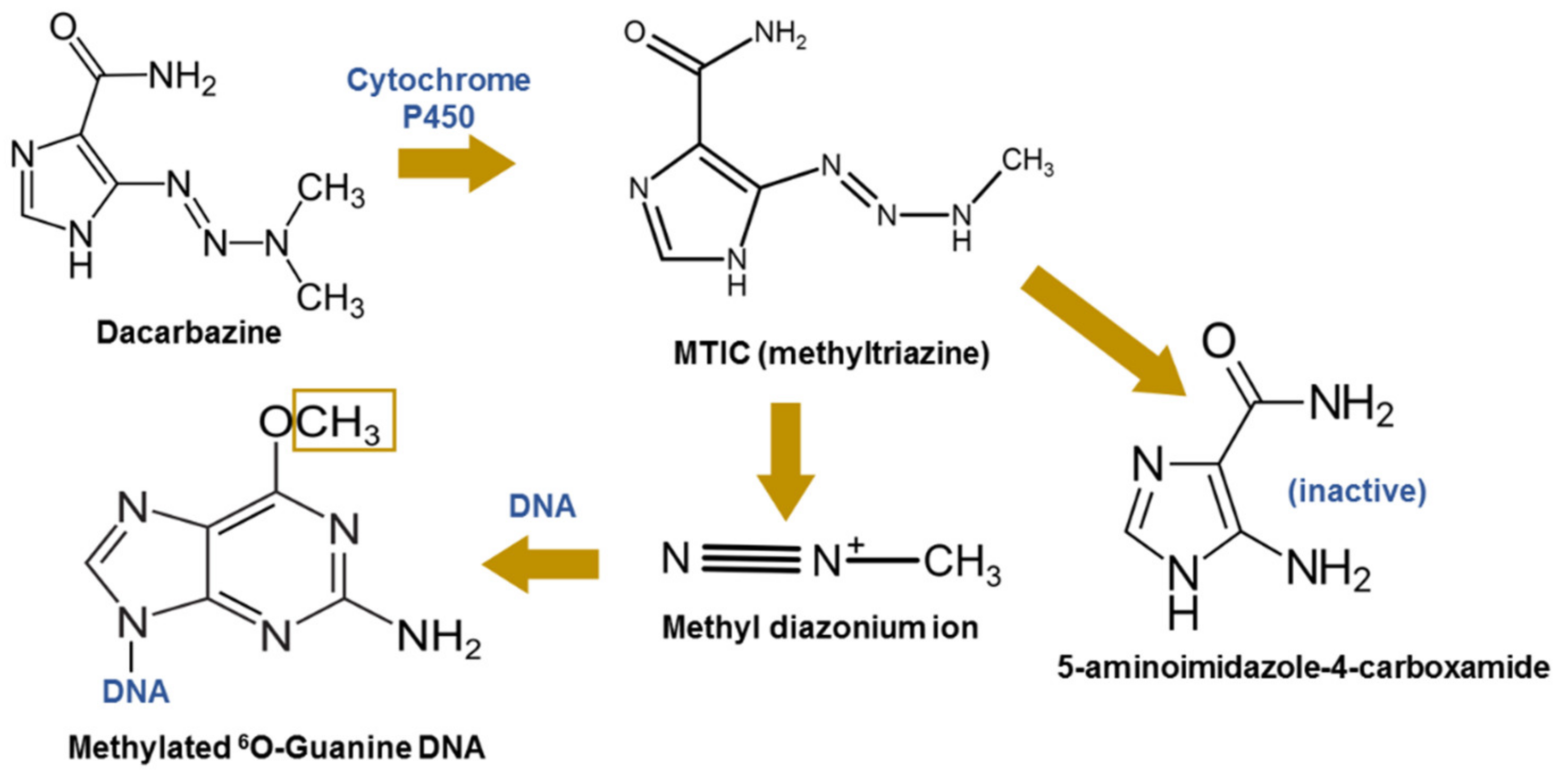
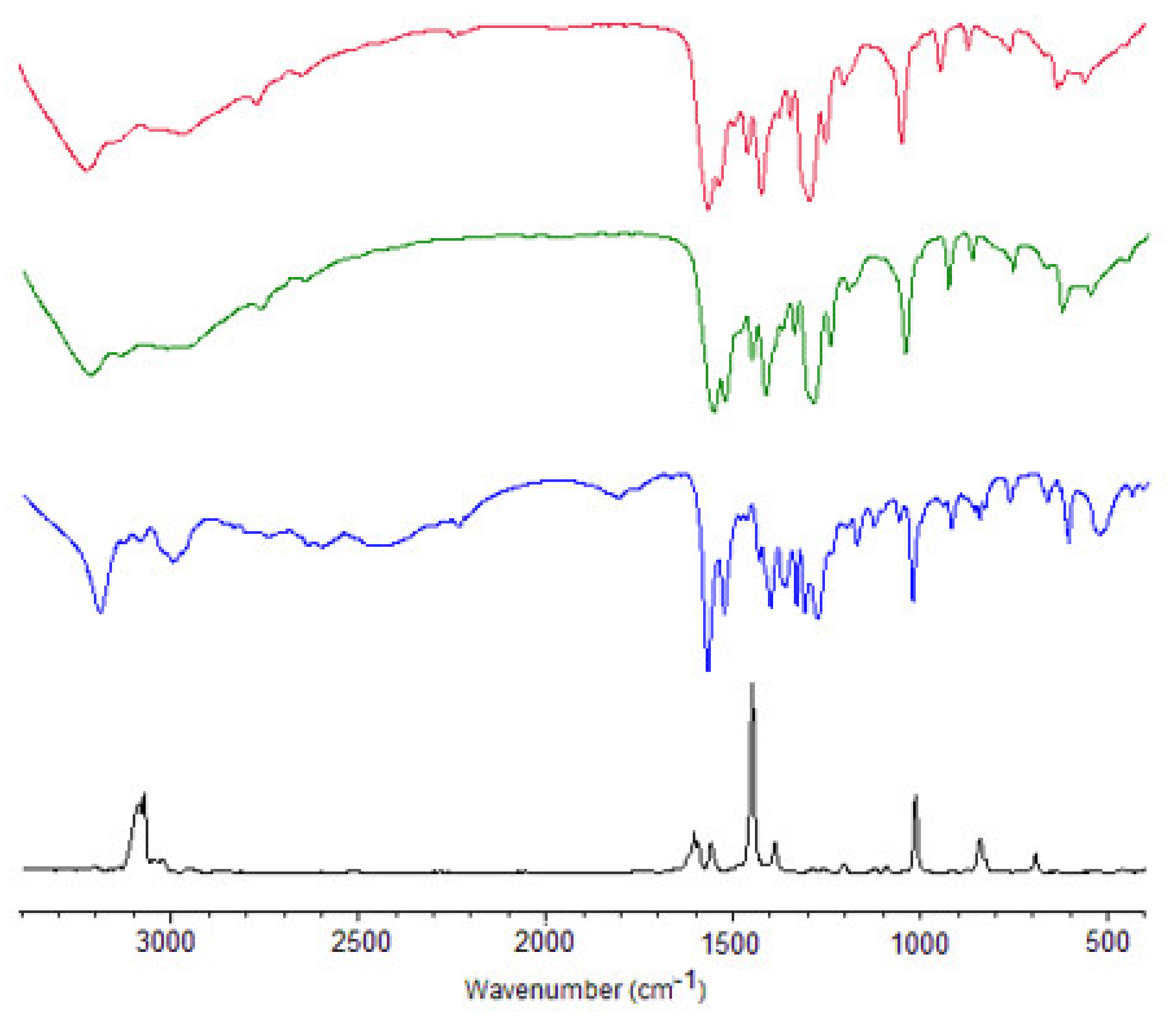
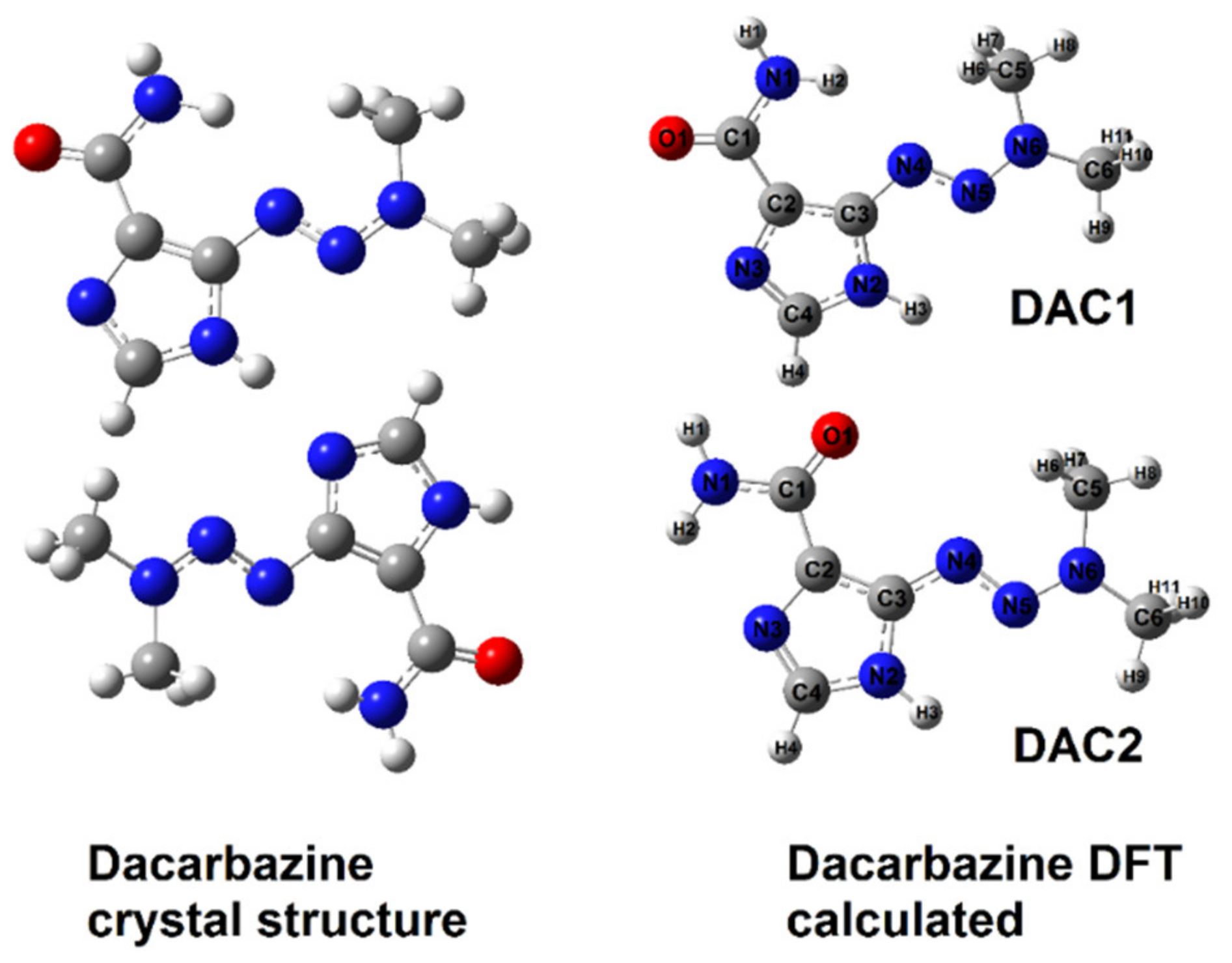

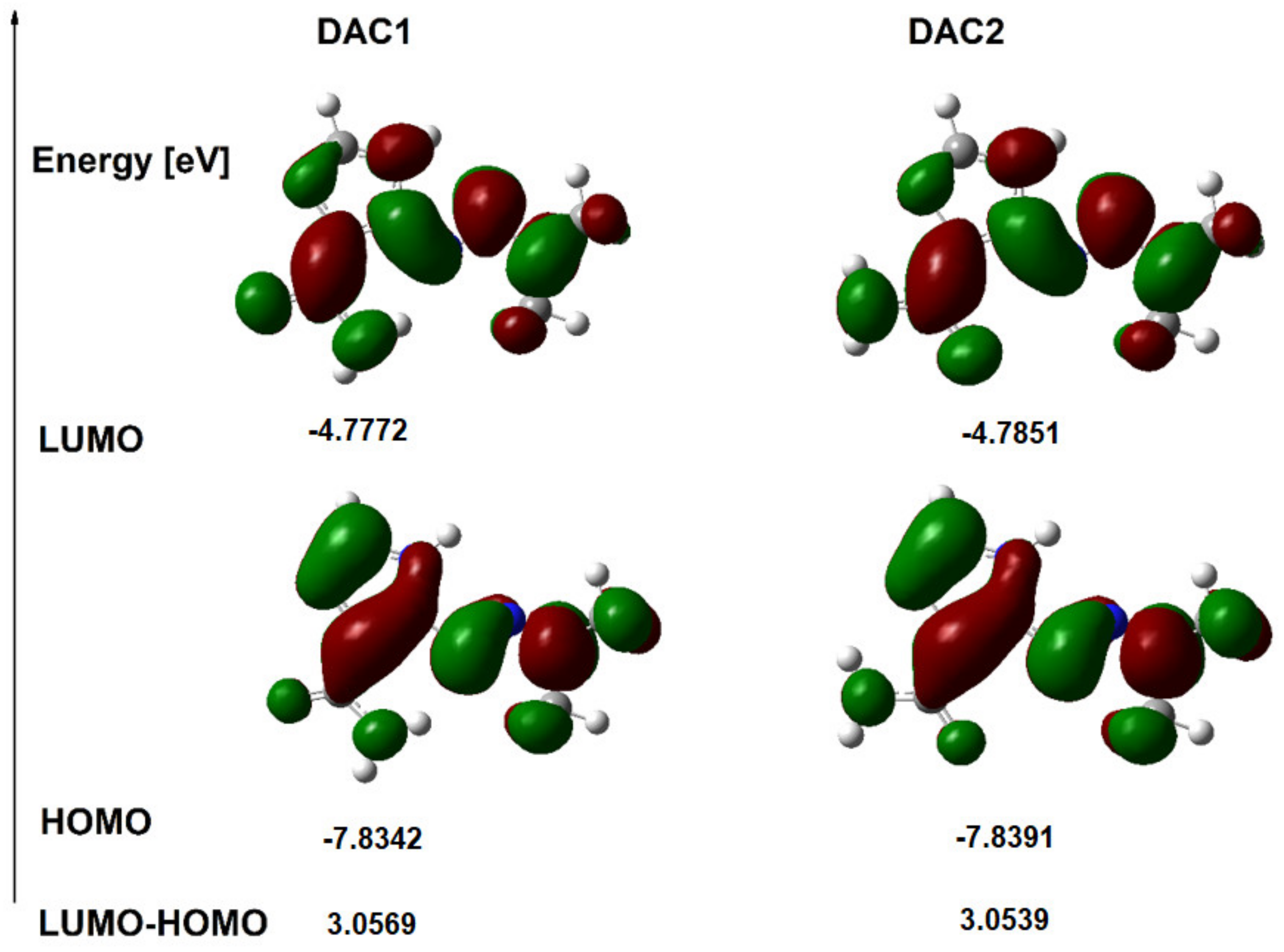
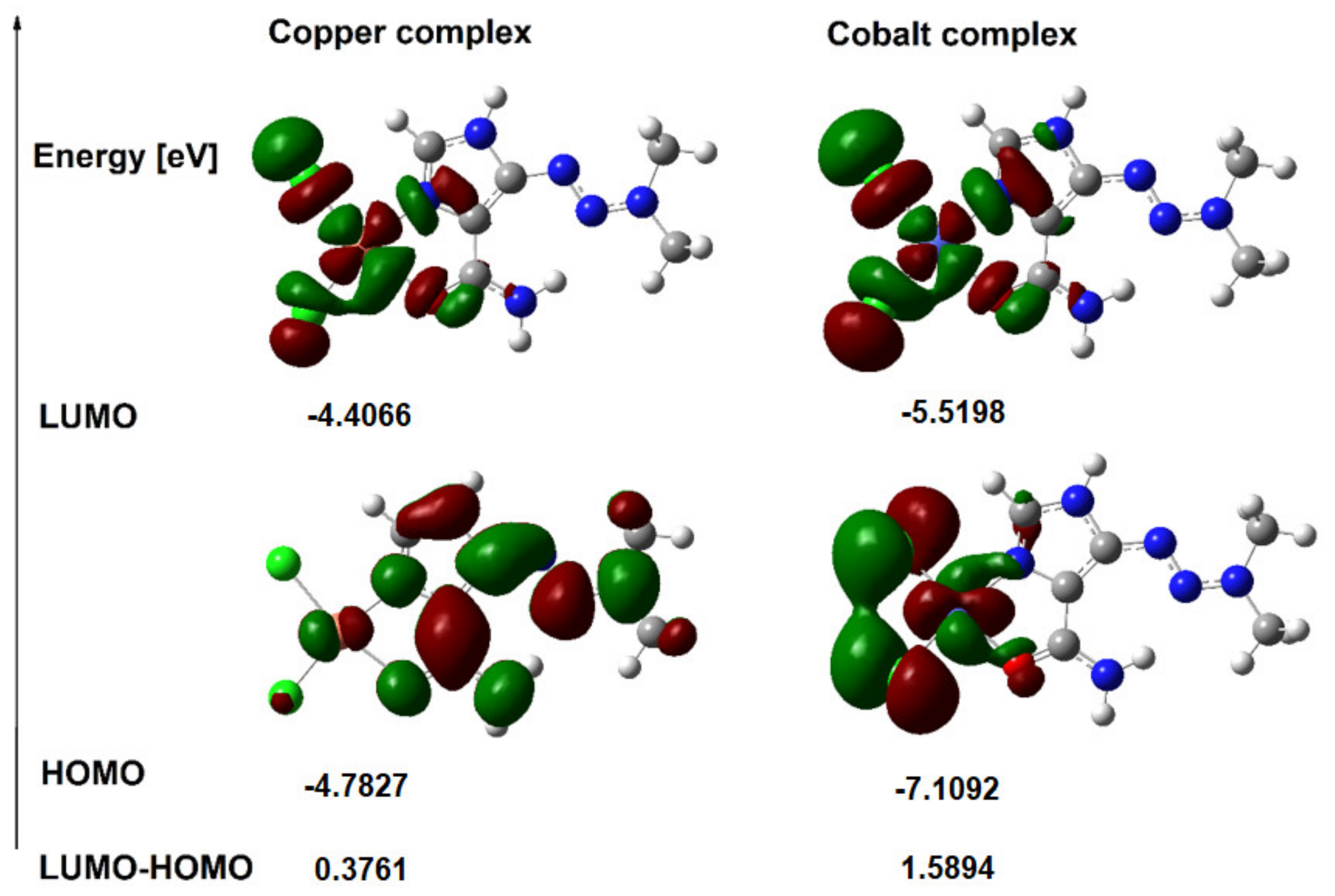
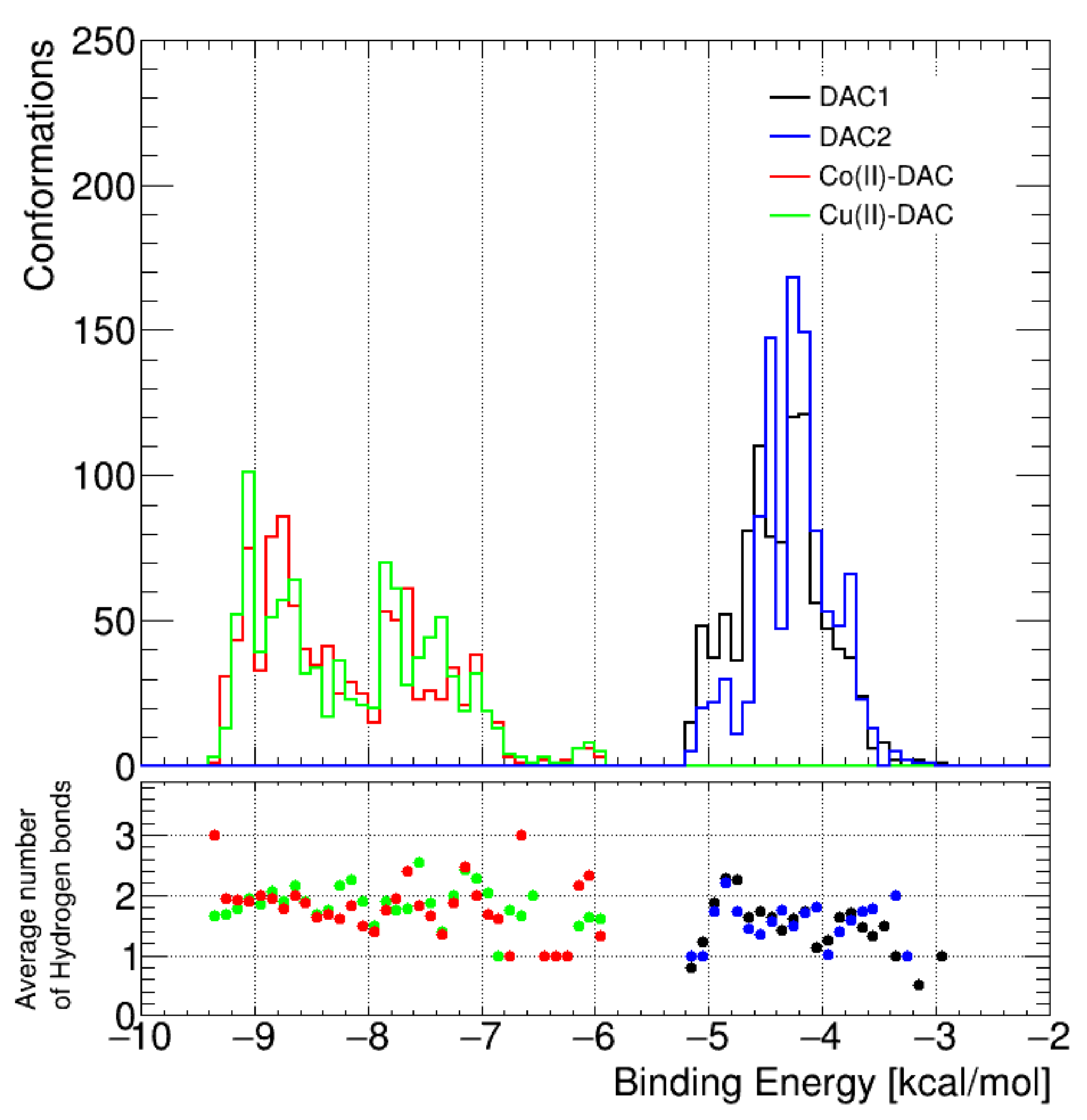

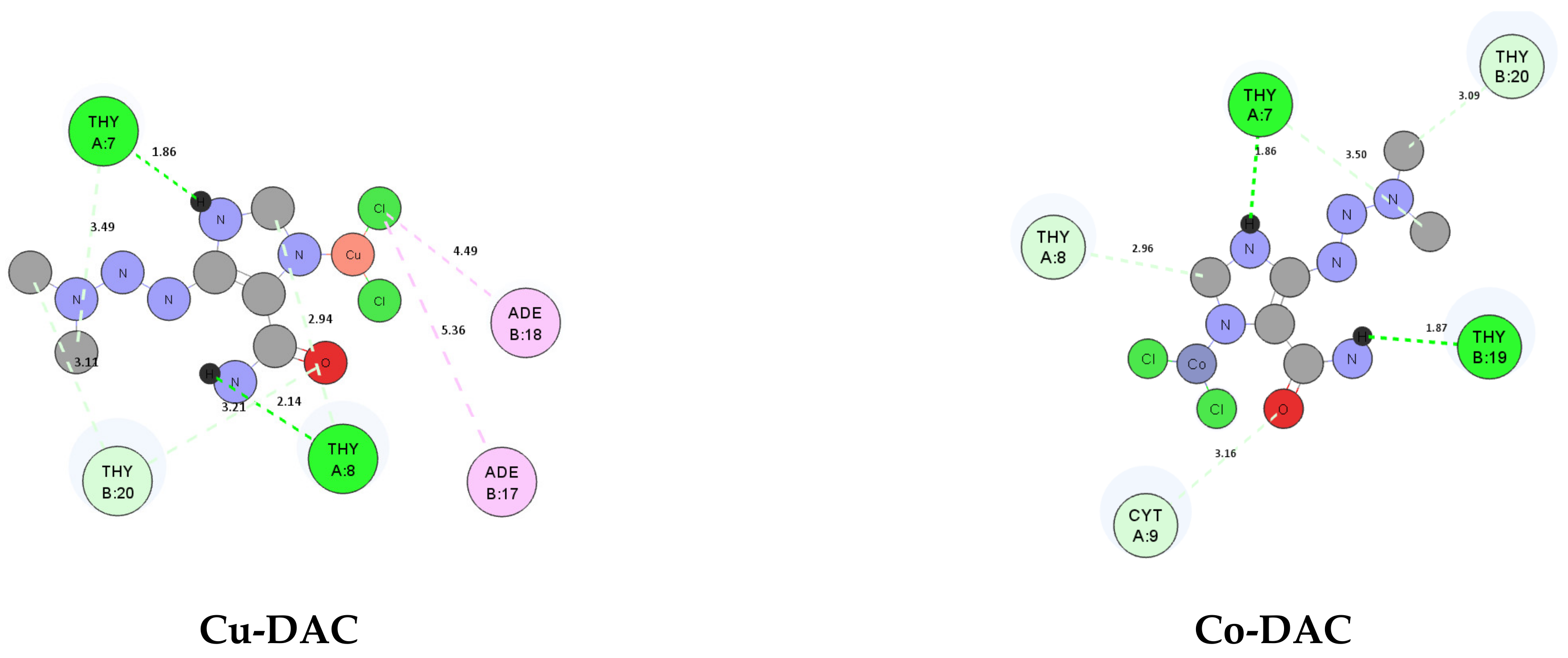
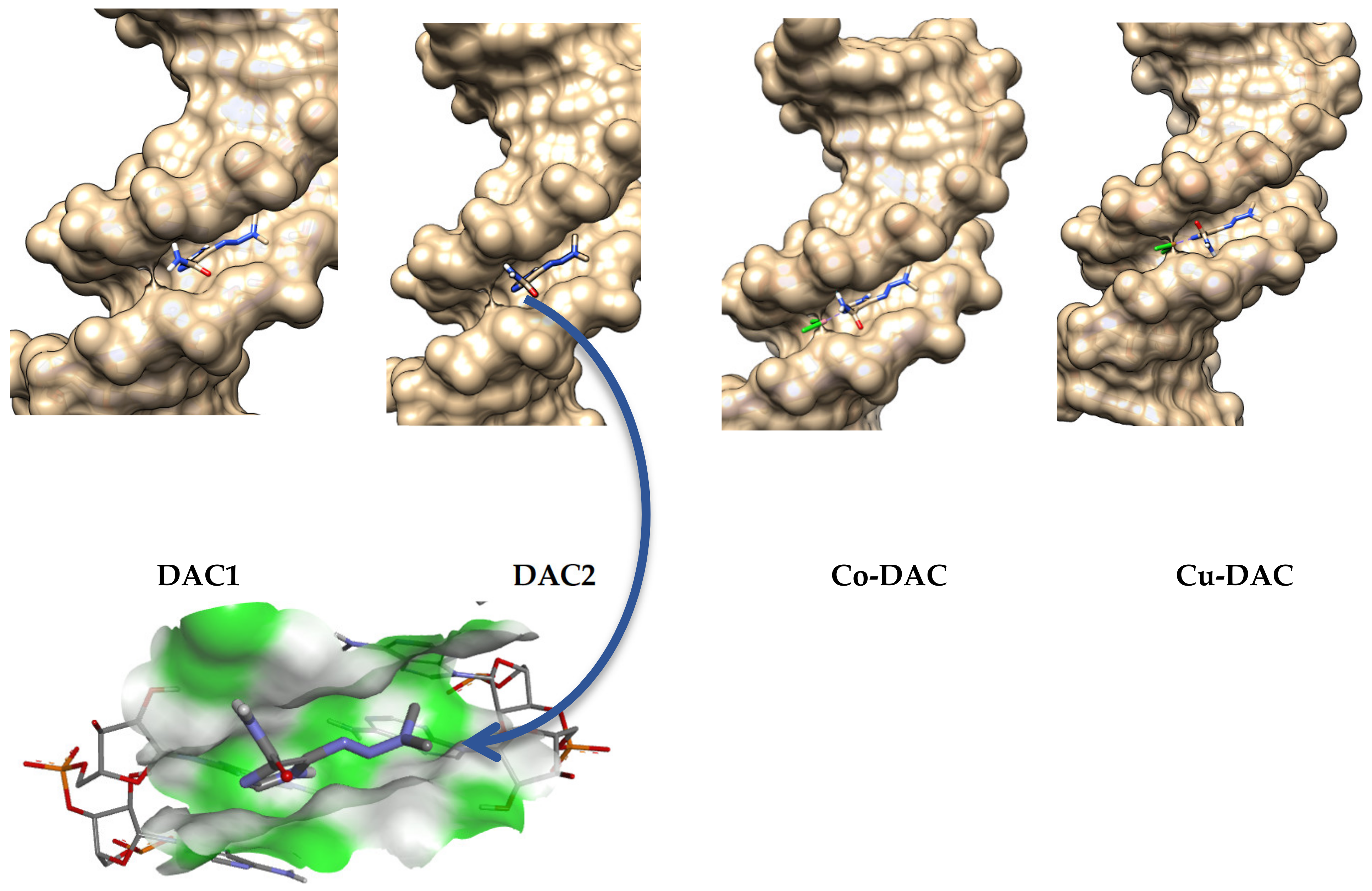
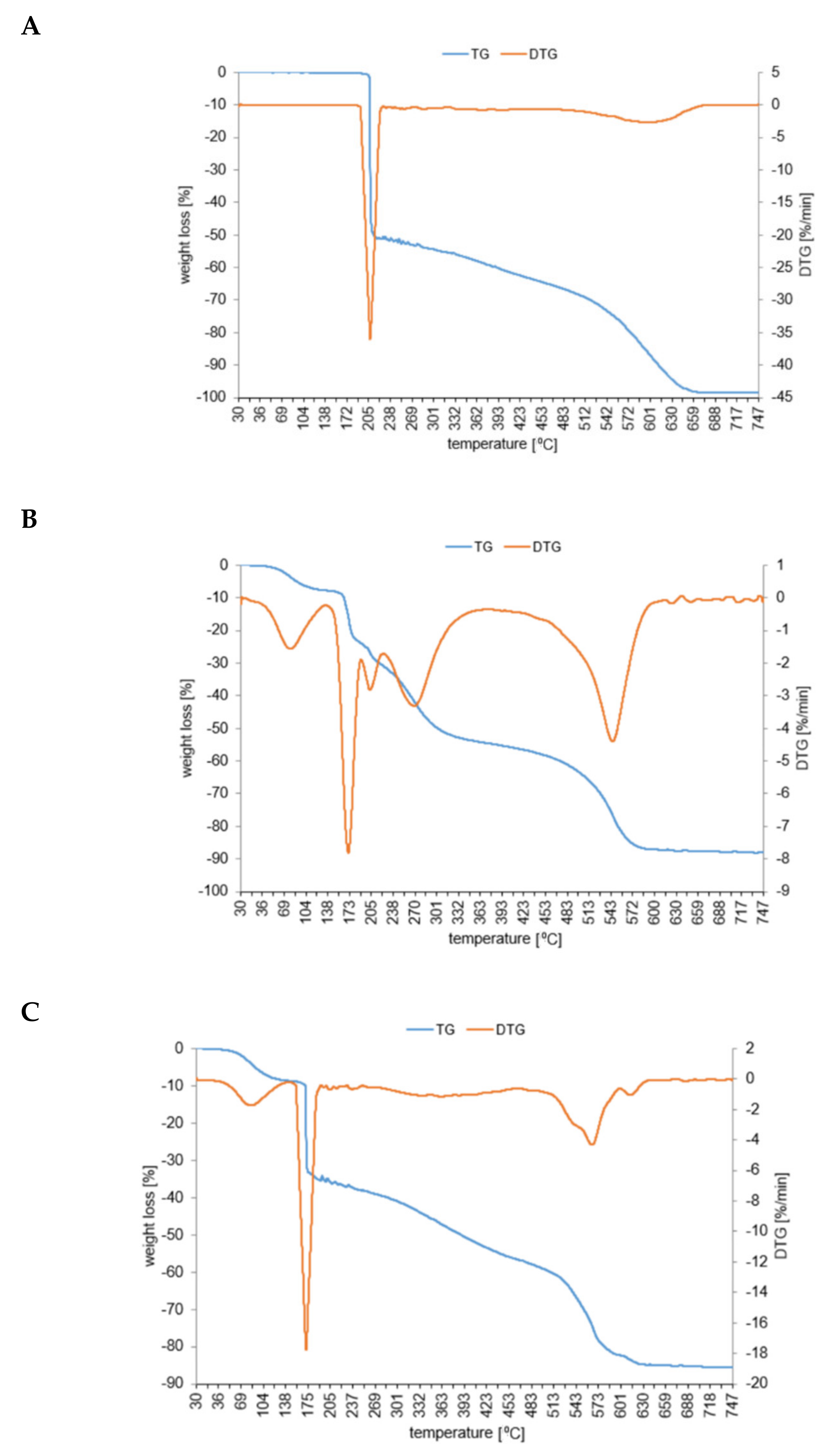
| Calculated IR (B3LYP 6-311G(d,p) | Experimental Spectra (cm−1) | |||||||||
|---|---|---|---|---|---|---|---|---|---|---|
| DAC 1 | DAC 2 | DAC | Cobalt Complex | Copper Complex | ||||||
| Unscaled | Scaled = 0.967 | Intensity | Unscaled | Scaled = 0.967 | Intensity | IR | Raman | IR | IR | Assignments |
| 3703 | 3581 | 105.50 | 3728 | 3605 | 72.84 | 3383 s | 3371 w | 3406 s | 3406 s | νasNH2 |
| 3647 | 3527 | 58.23 | 3560 | 3443 | 65.93 | - | - | 3322 s | - | νNH |
| 3549 | 3432 | 60.67 | 3585 | 3467 | 53.44 | 3269 m | - | - | - | νsNH2 |
| 3238 | 3131 | 2.26 | 3240 | 3133 | 2.09 | 3174 m | - | 3188 s | 3186 s | νCHar |
| 3144 | 3040 | 7.76 | 3143 | 3039 | 11.28 | 3147 m | 3141 vw | - | - | νsCH3 |
| 3139 | 3035 | 8.76 | 3139 | 3035 | 5.32 | 2964 m | - | - | - | ρsCH |
| 3085 | 2983 | 13.51 | 3097 | 2995 | 15.07 | 2905 m | 2925 m | 2923 m | νasCH3 | |
| 3078 | 2976 | 26.13 | 3074 | 2973 | 28.84 | 2793 m | - | - | 2796 w | νasCH3 |
| 3014 | 2915 | 47.62 | 3021 | 2921 | 40.93 | 2753 m | - | - | - | νsCH3 |
| 3003 | 2904 | 78.48 | 2997 | 2898 | 94.76 | 2612 m | - | - | - | νsCH3 |
| 1749 | 1691 | 494.07 | 1740 | 1683 | 326.18 | 1609 vs | 1604 w | 1605 s | 1609 s | νC=O |
| - | - | - | - | - | - | 1656 vs | - | 1637 vs | 1639 vs | νCH3 |
| 1620 | 1567 | 141.69 | 1607 | 1554 | 256.98 | - | - | - | - | ρC-NH2 |
| - | - | - | - | - | - | 1561 w | 1559 w | 1561 m | 1566 m | ρsCH3 |
| 1569 | 1517 | 3.59 | 1586 | 1534 | 55.59 | 1510 m | 1525 s | 1528 s | νCN | |
| 1527 | 1477 | 197.90 | 1525 | 1475 | 155.81 | 1476 s | 1488 vw | 1487 vs | 1488 vs | ρC-NH2 |
| 1483 | 1434 | 27.90 | 1481 | 1432 | 25.74 | 1436 m | 1449 vs | 1440 m | 1440 m | ρNH2 |
| 1451 | 1403 | 75.22 | 1453 | 1405 | 32.35 | 1402 s | - | 1405 m | 1405 m | νCC, νring, ρNH2 |
| 1438 | 1391 | 5.80 | 1438 | 1391 | 9.68 | - | - | - | - | νCC, αN-CH2, βNCH |
| 1431 | 1384 | 47.98 | 1430 | 1383 | 74.13 | 1381 s | 1388 w | - | - | βasCH3, νring |
| 1389 | 1343 | 21.23 | 1388 | 1342 | 24.58 | 1344 s | - | 1352 vs | 1351 vs | βsCH3, νring |
| 1363 | 1318 | 114.39 | 1367 | 1322 | 408.84 | 1304 m | - | 1306 s | 1307 s | βsCH3, νring |
| 1331 | 1287 | 36.74 | 1328 | 1284 | 40.87 | 1270 w | 1289 vw | - | - | βsCH3, νring, βNCH |
| 1270 | 1228 | 2.30 | 1260 | 1218 | 16.53 | 1259 w | 1258 vw | 1253 vs | 1255 m | νCN, βCH |
| 1231 | 1190 | 67.15 | 1233 | 1192 | 20.71 | 1231 m | 1204 vw | - | - | νring, βCH |
| 1153 | 1115 | 25.50 | 1152 | 1114 | 39.12 | 1183 w | - | - | - | βCH + νNN |
| 1136 | 1099 | 26.51 | 1137 | 1099 | 9.08 | 1072 s | 1091 vw | 1091 s | 1091 s | νNN, βCH |
| 1114 | 1077 | 24.06 | 1110 | 1073 | 7.62 | - | - | - | - | βCH + βCNC |
| 1091 | 1055 | 202.22 | 1093 | 1057 | 17.91 | 1049 w | 1012 m | - | - | ρCH2, βCH |
| 1084 | 1048 | 12.72 | 1075 | 1040 | 117.70 | 986 w | - | - | - | ρC-NH2, βCNC |
| 1062 | 1027 | 14.22 | 1061 | 1026 | 18.40 | 962 w | - | 969 m | 980 w | ρCH2, βCNC |
| 951 | 920 | 4.32 | 955 | 923 | 15.06 | 904 w | 913 vw | 902 w | 902 w | ρCH3, βCH |
| 915 | 885 | 14.86 | 912 | 882 | 16.25 | 896 w | - | - | - | ρCH3, νring |
| 817 | 790 | 9.74 | 812 | 785 | 5.02 | 882 w | - | - | - | Δring, νring(CN) |
| 799 | 773 | 2.21 | 799 | 773 | 2.40 | 868 w | 873 vw | - | - | ρCH3, νring |
| 797 | 771 | 10.95 | 798 | 772 | 14.79 | 796 w | - | - | - | βNCH, βNCC |
| 672 | 650 | 13.44 | 683 | 660 | 14.27 | 690 w | 691 w | - | - | βNH, βCCO |
| 668 | 646 | 0.82 | 679 | 657 | 0.01 | 653 vw | - | - | - | β(CCN + NH) |
| 632 | 611 | 25.62 | 602 | 582 | 43.51 | 630 m | - | 646 m | 649 m | αNNN, αCNC |
| 586 | 567 | 0.50 | 596 | 576 | 0.65 | 542 m | - | 565 m | 568 m | ρNH2, αNNH, αCCO |
| 552 | 534 | 73.21 | 574 | 555 | 104.33 | 450 w | 445 vw | - | - | ringdef |
| 550 | 532 | 39.82 | 568 | 549 | 10.64 | - | - | - | - | ringdef |
| 447 | 432 | 10.01 | 449 | 434 | 11.86 | 416 vw | - | - | - | αC-NH2 |
| DAC 1 | DAC 2 | Dacarbazine Complexes | |||
|---|---|---|---|---|---|
| Cobalt | Copper | ||||
| H (amide group) | Exp. | 7.29, 7.41 | - | 6.20, 5.40 | - |
| Theoret. | 6.86, 4.57 | 6.87, 4.40 | 6.38 | 8.29, 5.42 | |
| H (CHring) | Exp. | 7.83 | - | 8.04 | - |
| Theoret. | 7.20 | 6.98 | 8.90 | 7.74 | |
| H (NHring) | Exp. | 11.52 | - | - | - |
| Theoret. | 8.56 | 8.72 | 9.43 | 8.81 | |
| H (CH3-triazene group) | Exp. | 3.13, 3.50 | - | 3.49 | - |
| Theoret. | 3.67, 3.48, 3.36, 3.19, 2.29, 2.59 | 4.73, 4.37, 3.91, 3.88, 3.69, 3.17 | 3.78, 3.74, 3.71, 3.44, 3.34, 3.14 | 3.62, 3.61, 3.61, 3.24, 3.23, 3.03 | |
| Dacarbazine | Copper Complex | Cobalt Complex | ||||
|---|---|---|---|---|---|---|
| Exp [46] | DAC1 | DAC2 | Exp [47] | Calc | Calc | |
| Energy | - | −638.54 | −638.54 | - | −3199.60 | −2941.88 |
| Dipole m | - | 10.7498 | 5.5647 | - | 21.8411 | 22.5754 |
| Aromaticity indices | ||||||
| HOMA | 0.905 | 0.893 | 0.880 | 0.925 | 0.897 | 0.890 |
| GEO | 0.060 | 0.069 | 0.079 | 0.057 | 0.065 | 0.067 |
| EN | 0.035 | 0.039 | 0.041 | 0.017 | 0.039 | 0.043 |
| I5 | 67.97 | 67.39 | 65.35 | 70.44 | 68.42 | 67.68 |
| Bond lengths [A] | ||||||
| C1-O1 | 1.230 | 1.218 | 1.222 | 1.362 | 1.236 | 1.247 |
| C1-N1 | 1.338 | 1.370 | 1.366 | 1.309 | 1.345 | 1.342 |
| C1-C2 | 1.470 | 1.492 | 1.484 | 1.460 | 1.477 | 1.465 |
| C2-C3 | 1.379 | 1.392 | 1.388 | 1.387 | 1.393 | 1.392 |
| C3-N2 | 1.375 | 1.377 | 1.381 | 1.370 | 1.383 | 1.381 |
| N2-C4 | 1.352 | 1.370 | 1.367 | 1.345 | 1.356 | 1.359 |
| C4-N3 | 1.333 | 1.307 | 1.309 | 1.311 | 1.311 | 1.312 |
| N3-C2 | 1.387 | 1.376 | 1.383 | 1.379 | 1.379 | 1.384 |
| C3-N4 | 1.383 | 1.384 | 1.380 | 1.387 | 1.382 | 1.380 |
| N4-N5 | 1.285 | 1.270 | 1.279 | 1.286 | 1.273 | 1.274 |
| N5-N6 | 1.304 | 1.325 | 1.326 | 1.299 | 1.314 | 1.313 |
| N6-C5 | 1.451 | 1.456 | 1.458 | 1.450 | 1.455 | 1.455 |
| N6-C6 | 1.449 | 1.453 | 1.451 | 1.450 | 1.458 | 1.458 |
| Angles (°) | ||||||
| N2-C3-N4 | 127.50 | 125.36 | 125.07 | 116.37 | 115.48 | 116.15 |
| C3-N4-N5 | 112.80 | 113.71 | 113.23 | 112.17 | 115.88 | 115.46 |
| N4-N5-N6 | 113.42 | 115.20 | 114.26 | 114.66 | 114.71 | 114.64 |
| N5-N6-C6 | 116.55 | 115.90 | 116.01 | 122.46 | 121.71 | 121.70 |
| C5-N6-C6 | 120.96 | 120.43 | 120.46 | 120.31 | 120.82 | 120.76 |
| C1-C2-N3 | 120.18 | 120.93 | 121.18 | 112.88 | 113.31 | 112.19 |
| O1-C1-N1 | 123.28 | 122.53 | 123.17 | 121.95 | 122.79 | 122.19 |
| DAC1 | DAC2 | Copper Complex | Cobalt Complex | |
|---|---|---|---|---|
| O1 | −0.605 | −0.805 | −0.607 | −0.582 |
| N1 | −0.820 | −0.627 | −0.775 | −0.764 |
| C1 | 0.635 | 0.635 | 0.647 | 0.648 |
| C2 | 0.021 | 0.013 | 0.008 | −0.002 |
| C3 | 0.283 | 0.307 | 0.314 | 0.321 |
| N2 | −0.555 | −0.552 | −0.514 | −0.513 |
| C4 | 0.219 | 0.220 | 0.279 | 0.276 |
| N3 | −0.444 | −0.509 | −0.518 | −0.470 |
| qring | −0.476 | −0.521 | −0.431 | −0.388 |
| N4 | −0.346 | −0.296 | −0.343 | −0.343 |
| N5 | −0.034 | −0.047 | −0.032 | −0.031 |
| N6 | −0.248 | −0.246 | −0.215 | 0.213 |
| C5 | −0.390 | −0.392 | −0.390 | −0.390 |
| C6 | −0.349 | −0.349 | −0.349 | −0.349 |
| DAC1 | DAC2 | Copper Complex | Cobalt Complex | |
|---|---|---|---|---|
| HOMO | −7.8342 | −7.8391 | −4.7827 | −7.1092 |
| LUMO | −4.7772 | −4.7851 | −4.4066 | −5.5198 |
| Energy gap | 3.057 | 3.054 | 0.3761 | 1.5894 |
| Ionization potential | 7.8342 | 7.8391 | 4.7827 | 7.1092 |
| Electron affinity | 4.7772 | 4.7851 | 4.4066 | 5.5198 |
| Electronegativity | 6.3057 | 6.3121 | 4.59465 | 6.3145 |
| Chemical potential | −6.3057 | −6.3121 | −4.59465 | −6.3145 |
| Chemical hardness | 1.5285 | 1.527 | 0.18805 | 0.7947 |
| Chemical softness | 0.327118 | 0.327439 | 2.658867 | 0.629168 |
| Electrophilicity index | 13.00682 | 13.04604 | 56.13084 | 25.08677 |
| Free Energy of Binding (kcal/mol) | Inhibition Constant (µM) | Intermolecular Energy | Torsional Energy | Unbound Extended Energy | Interacting Residues (H-Bonds) and Distance [Å] | Reference RMSD | |
|---|---|---|---|---|---|---|---|
| DAC 1 | −5.17 | 163 | −5.99 | 0.82 | −0.38 | N1-THY B:19 (1.92) N2-THY A:7 (2.11) | 25.45 |
| DAC 2 | −5.13 | 173.91 | −5.95 | 0.82 | −0.37 | N1-THY B:19 (1.96) N2:THY A:7 (2.11) | 25.43 |
| Cu-DAC | −9.31 | 0.15106 | −10.40 | +1.10 | −0.63 | N1-THY:A8 (2.19) N2-THY A:7 (1.86) | 25.26 |
| Co-DAC | −9.33 | 0.14391 | −10.43 | +1.10 | −0.56 | N2-THY A:7 (1.86) N1-THY B:19 (1.87) | 26.06 |
| Compound | Range of Decomposition | Weight Loss (%) | Products of Decomposition | |
|---|---|---|---|---|
| Calcd. | Found | |||
| Dacarbazine | 205–210 | 47.70 | 48.50 | Imidazole +C* |
| 210–660 | 100 | 100 | - | |
| CoCl2(Dac)2·75CH3OH | 60–120 175–630 | 10.19 86.38 | 10.34 85.61 | CoCl2(Dac)2 CoO |
| CuCl2(Dac)2·1.5CH3OH | 60–110 160–580 | 8.78 85.40 | 8.39 87.16 | CuCl2(Dac)2 CuO |
Publisher’s Note: MDPI stays neutral with regard to jurisdictional claims in published maps and institutional affiliations. |
© 2021 by the authors. Licensee MDPI, Basel, Switzerland. This article is an open access article distributed under the terms and conditions of the Creative Commons Attribution (CC BY) license (https://creativecommons.org/licenses/by/4.0/).
Share and Cite
Świderski, G.; Łaźny, R.; Sienkiewicz, M.; Kalinowska, M.; Świsłocka, R.; Acar, A.O.; Golonko, A.; Matejczyk, M.; Lewandowski, W. Synthesis, Spectroscopic, and Theoretical Study of Copper and Cobalt Complexes with Dacarbazine. Materials 2021, 14, 3274. https://doi.org/10.3390/ma14123274
Świderski G, Łaźny R, Sienkiewicz M, Kalinowska M, Świsłocka R, Acar AO, Golonko A, Matejczyk M, Lewandowski W. Synthesis, Spectroscopic, and Theoretical Study of Copper and Cobalt Complexes with Dacarbazine. Materials. 2021; 14(12):3274. https://doi.org/10.3390/ma14123274
Chicago/Turabian StyleŚwiderski, Grzegorz, Ryszard Łaźny, Michał Sienkiewicz, Monika Kalinowska, Renata Świsłocka, Ali Osman Acar, Aleksandra Golonko, Marzena Matejczyk, and Włodzimierz Lewandowski. 2021. "Synthesis, Spectroscopic, and Theoretical Study of Copper and Cobalt Complexes with Dacarbazine" Materials 14, no. 12: 3274. https://doi.org/10.3390/ma14123274
APA StyleŚwiderski, G., Łaźny, R., Sienkiewicz, M., Kalinowska, M., Świsłocka, R., Acar, A. O., Golonko, A., Matejczyk, M., & Lewandowski, W. (2021). Synthesis, Spectroscopic, and Theoretical Study of Copper and Cobalt Complexes with Dacarbazine. Materials, 14(12), 3274. https://doi.org/10.3390/ma14123274








